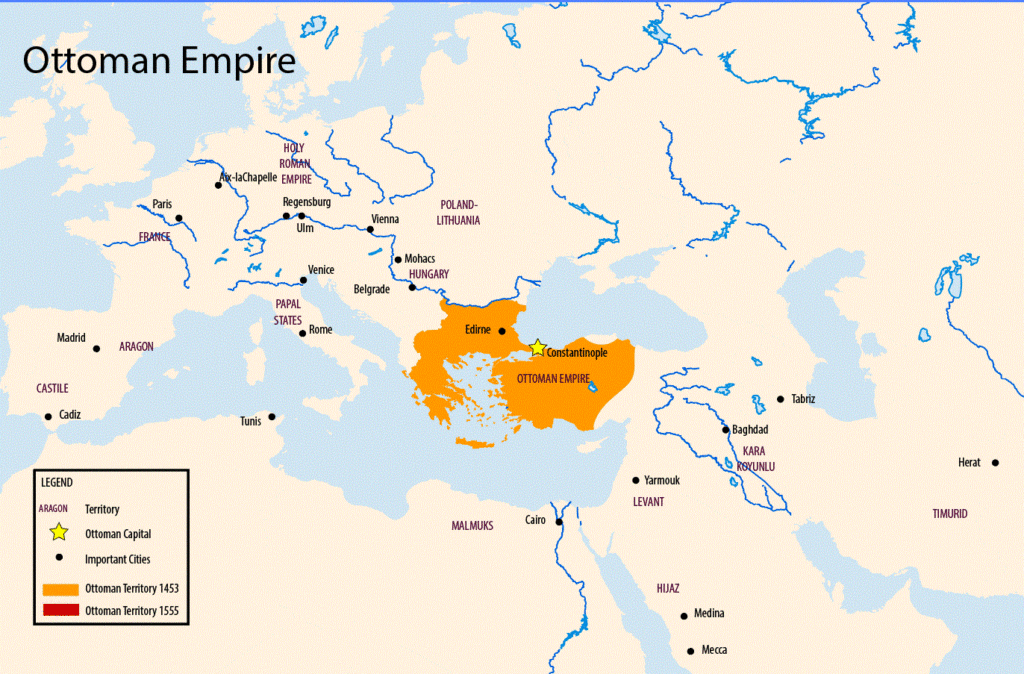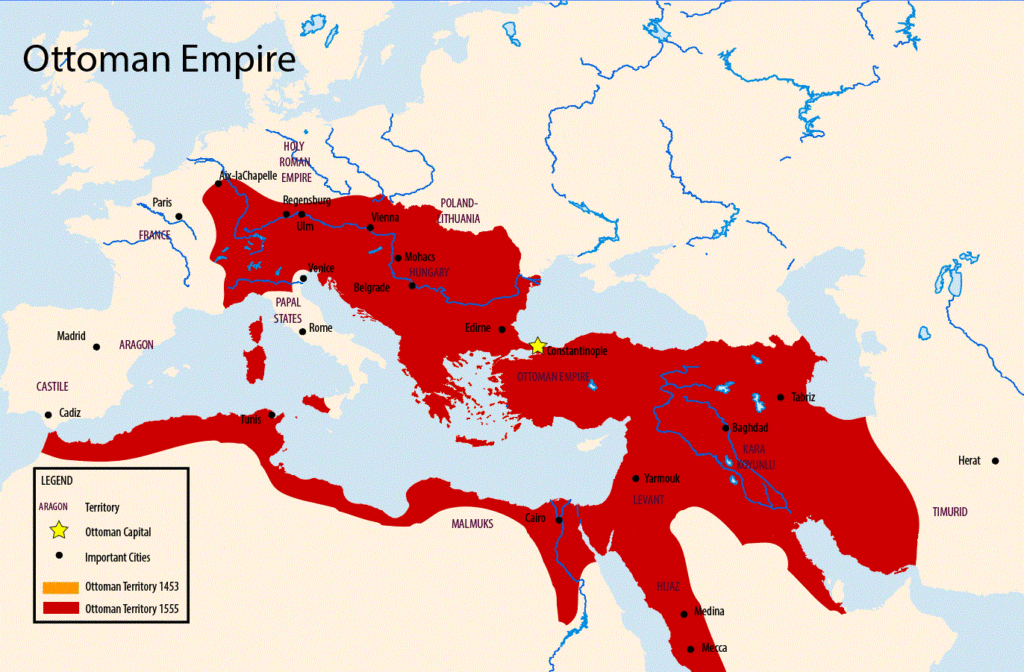Chronology of the Ottoman Golden Age
The Ottoman Conquest of Europe – Chronology
Key Events
- War against Shah Ismail of Persia; Shia uprising in Ottoman territories.
- Persians defeated at Chaldiran.
- Ottomans take Tabriz, looting the Royal Library. The Ottomans take many manuscripts along with many Persian artists back to Istanbul. Attempt to take Bezhad and his atelier to Istanbul fails as he is secretly ushered to Herat to avoid capture.
- End of Shia revolts in Ottoman territories.
- Ottomans sack Cairo, end Malmuk rule in Egypt.
- Selim I (father of Suleiman) takes Egypt, Syria.
- Martin Luther posts 95 thesis on Wittenberg Cathedral.
- Ottoman invasion of Hungary.
- Ottomans capture Belgrade, island of Rhodes.
- Shah Ismail dies; his 10-year old son Shah Tahmasp (1524-1574) takes over.
- Bezhad immediately recalled to Tabriz.
-
Turks take Ofen.
- Bezhad travels to Istanbul to work with the Naqqash-Khaneh (House of Painters) with 9 other Persian painters from Tabriz; Bezhad soon after becomes the royal painter of Suleiman.
- Suleiman is crowned Imperial Sultan of Europe and the Hijaz at aix-la-Chapelle, in the same place Charlemagne was crowned Holy Roman Emperor.
- Disarray in what is left of the Holy Roman Empire.
- Charles V flees to Spain.
- Protestant uprisings force Francis I (with the backing of the Pope) to invade the Netherlands and Koln.
- Safavid Persians invade Eastern Ottoman Empire, begin Ottoman-Safavid War (1532-1555); Suleiman forced to fight on two fronts.
- Vienna Mosque construction begins.
- Charles V captures Tunis, then is repelled back to Spain
- Ferdinand is defeated at Cadiz.
- Pasha Ibrahim reaches Granada.
- Persia aligns with Charles V to fight the Ottomans breaking the peace.
- France aligns with the Ottomans.
- Ottomans occupy Baghdad.
- Suleiman’s engineers begin canal to connect Rhine and Danube to protect Ottoman interests in their Western Empire.
- Peace of Regensburg (1534) – establishes border of Ottoman territory
- Suleiman retains lands around the Danube, north of the Alps, and Hungary.
- Poles ally with Suleiman against Russian threat.
- Venice becomes a vassal state of the Ottoman Empire.
- France remains independent.
- Charles V retains northern Holy Roman Empire, Netherlands, and retains Spain with tribute payment of 30,000 ducats.
- Catholics receive dhimmi rights (right to free worship)
- “Unholy Alliance” formed – Suleiman agrees to help Charles V and Pope Paul III, to crush Protestant revolt in Europe in exchange for trading rights up the Rhine River and guarantee not occupy land north of the Danube.
-
Muzaffar Ali (Bezhad’s great-nephew becomes head of artist guild in Istanbul.
- Ottoman-Safavid War ends.
- Ottomans retain land up to Zagros mountains.
- Safavids retain the Iranian plateau and eastward.
- Battle between Biyazid and Selim to re-consolidate the Empire under a single ruler.
- Fighting breaks out along the Mediterranean Coast.
- Instability in Region.
- Battle of Lepanto (1571)
- “Unholy Alliance” finally ends as Papal States, France, and Holy Roman Empire advance on Biyazid.
- Catholic forces retake Scholssberg.
- Vienna besieged, sacked (1575)
- Biyazid defeated and killed by Selim at the Battle of Edirne (1576)

Ottoman Empire 1453
It took over 800 years for Islam to conquer Constantinople, but by the time the Ottomans celebrated its centenary, Suleiman I had vanquished most of Europe. Ottoman power was already on the rise thanks to Suleiman’s father Selim I, whose conquests included Syria, Egypt, and Hijaz. At the same time, Europe was fractured by ethnic and sectarian violence. It would take all of Suleiman’s statesmanship (and Ottoman armies) to unify Europe under one banner.
Suleiman I became Sultan in 1520, and almost immediately set his eyes upon Europe. He crossed the Bosporus and almost immediately captured Belgrade, and soon after took Hungary. By the time he was crowned Imperial Sultan of Europe, Maghreb, Mashreq and Hijaz, on August 26, 1531 (13-Muharram-938) at Aix-la-Chapelle, Suleiman had conquered most of the former Holy Roman Empire, made Venice, Poland and France vassal states, and rebuilt Vienna as his Western capital after laying siege in 1530 and finally taking the city in 1531.

Ottoman Empire 1555
Along with being a great military commander and statesman, Suleiman was a poet and patron of the arts. Many of the greatest mosques including the Suleymaniye (Istanbul), Selimiye (Edirne), and the Ibrahimiye (Vienna) mosques were commissioned by Suleiman or his son Selim. Baqi, Fuzuli, and Lamii produced works that are now considered pillars of the Classic Age of Ottoman verse. No longer constrained by repeating Persian forms, Suleiman encouraged an Ottoman culture, which like Alexander and Augustus, incorporated elements of the lands they had conquered, all while spreading distinctly Ottoman cultural and bureaucratic values.
Meanwhile in Persia, the Safavid ruler Ismail I died in 1524, leaving his 10-year old son Tahmasp I to rule. Suleiman continued to harry the Persians through his Grand Vizier Ibrahim Pasha, and briefly held the Safavid capital, Tabriz. While in Tabriz, Ibrahim met Kemaleddin Behzad, who was the court painter of the Safavid’s, and the most famous miniature painter in the Middle East. Ibrahim convinced Behzad to return with him to Istanbul to work with and mentor the Naggash-Khaneh (House of Painters). So important was Behzad, that during the last five years of his life, he accompanied Suleiman on his military campaigns and royal visits chronicling Suleiman’s achievements. Because he was often working in the unforgiving theater of war, Behzad was not able to complete the entire manuscript of new miniatures, but relied on previously produced folios from his oeuvre (perhaps favorites of Suleiman), that were modified with new calligraphy and small artistic changes to tell the story of Suleiman. This adds to one of the unique elements of this manuscript, as some of Baqi’s verse was written on new paper and then affixed over the top of the existing calligraphy from the original Behzad work.
